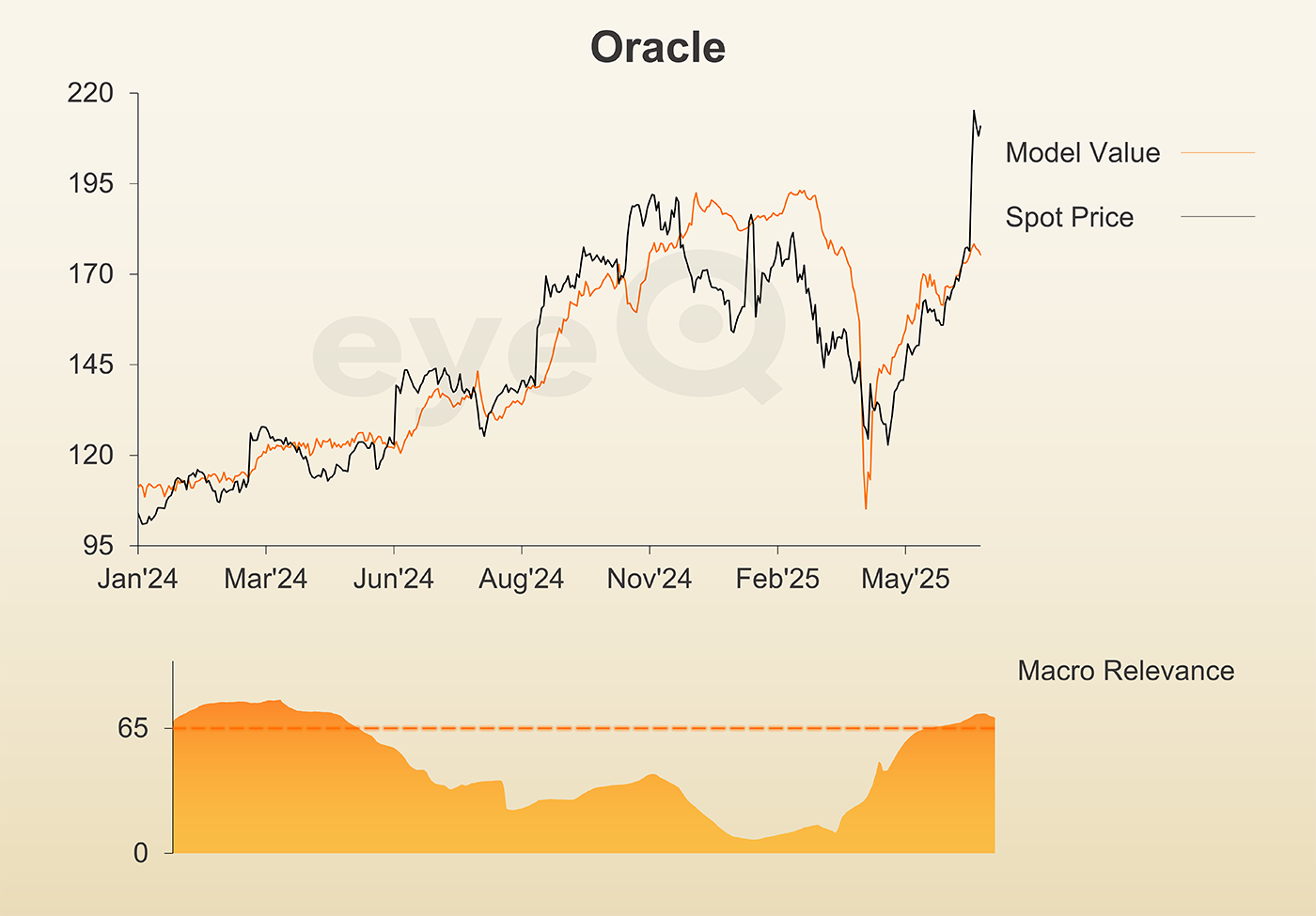eyeQ: an under-appreciated beneficiary of AI theme
Experts at eyeQ have used AI and their own smart machine to analyse macro conditions and generate actionable trading signals. There’s a serious discussion to be had about this stock.
19th June 2025 10:26
by Huw Roberts from eyeQ

“Our signals are crafted through macro-valuation, trend analysis, and meticulous back-testing. This combination ensures a comprehensive evaluation of an asset's value, market conditions, and historical performance.” eyeQ
- Discover: eyeQ analysis explained | eyeQ: our smart machine in action | Glossary
Oracle
Macro Relevance: 71%
Model Value: $175.36
Fair Value Gap: +16.84% premium to model value
Data correct as at 19 June 2025. Please click glossary for explanation of terms. Long-term strategic model.
Oracle Corp (NYSE:ORCL) has had a good week.
Last week it posted strong earnings, beating consensus estimates on both the top and bottom lines, and management sounded significantly more upbeat on guidance for the rest of 2025.
Then this week, well-known tech analyst Dan Ives argued that the artificial intelligence (AI) revolution is still only getting started and cited Oracle and International Business Machines Corp (NYSE:IBM) as under-appreciated beneficiaries. He actually drew parallels with Oracle today and Microsoft Corp (NASDAQ:MSFT) in mid-2023 just as the AI theme got going!
That’s the good news. And it is unambiguously good news!
The macro picture, however, is more cautious. The recent rally has taken the stock nearly 17% rich to macro conditions. Model value has been rising but there are signs that momentum has stalled.
So, this latest rally is exclusively about the AI theme. Fair enough, but note that we’re back in a macro regime for the first time in around a year, so macro shouldn’t be completely ignored.
In this instance there’s a caveat. While the machine has fired a bearish signal, such is the strength of the AI trade that we’d tweak the message. It’s less about a new bearish stance; more a warning that these aren’t the best levels to chase.
Be aware that macro forces could come to weigh on the stock price and give long-term AI bulls a potentially better entry level.

Source: eyeQ. Past performance is not a guide to future performance.
Useful terminology:
Model value
Where our smart machine calculates that any stock market index, single stock or exchange-traded fund (ETF) should be priced (the fair value) given the overall macroeconomic environment.
Model (macro) relevance
How confident we are in the model value. The higher the number the better! Above 65% means the macro environment is critical, so any valuation signals carry strong weight. Below 65%, we deem that something other than macro is driving the price.
Fair Value Gap (FVG)
The difference between our model value (fair value) and where the price currently is. A positive Fair Value Gap means the security is above the model value, which we refer to as “rich”. A negative FVG means that it's cheap. The bigger the FVG, the bigger the dislocation and therefore a better entry level for trades.
Long Term model
This model looks at share prices over the last 12 months, captures the company’s relationship with growth, inflation, currency shifts, central bank policy etc and calculates our key results - model value, model relevance, Fair Value Gap.
These third-party research articles are provided by eyeQ (Quant Insight). interactive investor does not make any representation as to the completeness, accuracy or timeliness of the information provided, nor do we accept any liability for any losses, costs, liabilities or expenses that may arise directly or indirectly from your use of, or reliance on, the information (except where we have acted negligently, fraudulently or in wilful default in relation to the production or distribution of the information).
The value of your investments may go down as well as up. You may not get back all the money that you invest.
Equity research is provided for information purposes only. Neither eyeQ (Quant Insight) nor interactive investor have considered your personal circumstances, and the information provided should not be considered a personal recommendation. If you are in any doubt as to the action you should take, please consult an authorised financial adviser.
Disclosure
We use a combination of fundamental and technical analysis in forming our view as to the valuation and prospects of an investment. Where relevant we have set out those particular matters we think are important in the above article, but further detail can be found here.
Please note that our article on this investment should not be considered to be a regular publication.
Details of all recommendations issued by ii during the previous 12-month period can be found here.
ii adheres to a strict code of conduct. Contributors may hold shares or have other interests in companies included in these portfolios, which could create a conflict of interests. Contributors intending to write about any financial instruments in which they have an interest are required to disclose such interest to ii and in the article itself. ii will at all times consider whether such interest impairs the objectivity of the recommendation.
In addition, individuals involved in the production of investment articles are subject to a personal account dealing restriction, which prevents them from placing a transaction in the specified instrument(s) for a period before and for five working days after such publication. This is to avoid personal interests conflicting with the interests of the recipients of those investment articles.